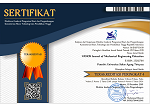Wing Simulation Using Naca 2412 and 2415 Airfoils with Variations in Angle of Attack for Lift and Drag
Abstract
The geometry of an airfoil plays a critical role in shaping an aircraft's performance, especially during maneuvering. This study emphasizes the necessity of conducting a comprehensive geometric analysis to better understand the effects of airfoil design. In pursuit of optimizing airfoil performance, we conducted extensive tests on NACA 2412 and 2415 series airfoil geometries using the ANSYS Fluent software. The tests employed Aluminum Alloy 1067 material and a wind speed of 300 m/s, encompassing a range of angle of attack variations from 0 to 180 degrees. The simulation results provided valuable insights into the velocity and pressure distributions surrounding the airfoil. Of particular interest, at an angle of 15 degrees, the NACA 2412 airfoil exhibited a maximum drag force of 69.670 N and a maximum lift force of 550.300 N. The corresponding drag and lift coefficients were 0,1516378 N and 1,1977364 N. For the NACA 2415 airfoil, the maximum drag and lift forces were 71.470 N and 564.500 N, respectively, with corresponding drag and lift coefficients of 0,1541963 N and 1,2179072 N.
Keywords
Full Text:
PDFReferences
D. Raymer, Aircraft Design: A Conceptual Approach, 5th ed. Washington DC: AIAA Inc, 2012.
A. Pope, Basic Wing and Airfoil Theory (Dover Books on Aeronautical Engineering), Illustrated. Dover Publications, 2009.
A. R. Buchalter and P. M. Miller, “The National Advisory Committee for Aeronautics: An Annotated Bibliography,” National Aeronautics and Space Administration.
National Advisory Committee for Aeronautics, “National Advisory Committee for Aeronautics,” Wikipedia.
I. Boyd Perry, “Results of National Advisory Committee for Aeronautics Report Number 496: Revisited,” J Aircr, vol. 53, no. 5, 2016.
R. Sankar Vaddi, C. Sota, A. Mamishev, and I. V Novosselov, “Active Flow Control of NACA 0012 airfoil using Sawtooth Direct Current Augmented Dielectric Barrier Discharge Plasma Actuator”.
B. Steenwijk and P. Druetta, “Numerical Study of Turbulent Flows over a NACA 0012 Airfoil: Insights into Its Performance and the Addition of a Slotted Flap,” Applied Sciences 2023, Vol. 13, Page 7890, vol. 13, no. 13, p. 7890, Jul. 2023, doi: 10.3390/APP13137890.
M. F. Hidayat, “Analisa Aerodinamika Airfoil Naca 0021 Dengan Ansys Fluent,” Jurnal Kajian Teknologi, vol. 10, no. 2, 2014.
M. Pane, “Simulasi Sayap Menggunakan Airfoil NACA 0008 dan 0010 dengan Variasi Sudut Serang terhadap Gaya Angkat dan Gaya Dorong,” J-Proteksion: Jurnal Kajian Ilmiah dan Teknologi Teknik Mesin, vol. 8, no. 1, 2023.
Y. Cao, Z. Wu, and Z. Xu, “Effects of rainfall on aircraft aerodynamics,” Progress in Aerospace Sciences, vol. 71, pp. 85–127, Nov. 2014, doi: 10.1016/J.PAEROSCI.2014.07.003.
R. E. Xu and Z. Wu, “Numerical Simulation of Flow Over Airfoil and Its Optimization,” J Phys Conf Ser, vol. 2441, no. 1, p. 012004, Mar. 2023, doi: 10.1088/1742-6596/2441/1/012004.
F. M. White, Mekanika Fkuida, 2nd ed. Erlangga, 1994.
R. D. Edfi, “Analisa Perubahan Gaya Angkat dan HambatanTotal Terhadap Variasi Aspect Ratio dan Winglet pada Sayap Kapal Wing in Surface Effect Menggunakan Aplikasi CFD,” Jurnal Teknik ITS, vol. 7, no. 2, 2018.
Y. Wahyudi, M. Agung, and Agung, “Pengaruh Distribusi Tekanan Terhadap Gaya Lift Airfoil NACA 23012 Pada Berbagai Variasi Angle Of Attack,” Jurnal Mechanical Engineering , 2021.
H. Wibowo, “Pengaruh Sudut Serang Aerfoil Terhadap Distribusi Tekanan dan Gaya Angkat,” Jurnal Dinamika Vokasional Teknik Mesin, vol. 2, no. 2, 2017.
I. ANSYS, “Ansys Fluent Fluid Simulation Software.” 2023.
G. S. Samy, S. T. Kumaran, M. Uthayakumar, and M. Sivasubramanian, “Numerical analysis of drag and lift coefficient of a Sport Utility Vehicle (SUV),” in International Conference on Recent Advances in Fluid and Thermal Sciences 5–7 December 2018, Dubai, U.A.E., Dubai: Journal of Physics: Conference Series, 2019.
D. Eller and S. Heinze, “Approach to Induced Drag Reduction with Experimental Evaluation,” J Aircr, vol. 42, no. 6, 2012.
T. Hidayah, “Solidworks,” Blogger. [Online]. Available: https://taufiqdrafting13.blogspot.com/2017/11/apa-sih-kelebihan-solidworks.html
S. T. P. Ltd, “SOLIDWORKS – Fungsi, Jenis dan Alasan Menggunakan SOLIDWORKS,” SEACAD Technologies Pte Ltd. [Online]. Available: https://webcache.googleusercontent.com/search?q=cache:RgVCYJBqwRUJ:https://seacadtech.co.id/id/tutorial-solidworks/&cd=1&hl=id&ct=clnk&gl=id
Dionisius, “ANSYS,” Teknologi Manufaktur. [Online]. Available: https://teknikmesinmanufaktur.blogspot.com/2015/01/apa-itu-ansys.html
M. Zhao, H. Cao, and M. Zhang, “Optimal Design of Wind Turbine Blades by Combination of Multi-airfoil Leaf Elements Optimal design of aeroacoustic airfoils with owl-inspired trailing-edge serrations”, doi: 10.1088/1742-6596/2235/1/012008.
A. Vardar and I. Alibas, “Research on wind turbine rotor models using NACA profiles,” Renew Energy, vol. 33, no. 7, pp. 1721–1732, Jul. 2008, doi: 10.1016/J.RENENE.2007.07.009.
UIUC Airfoil Coordinates Database, “NACA 2415 (naca2415-il),” UIUC Airfoil Coordinates Database,.
UIUC Airfoil Coordinates Database, “NACA 2412 (naca2412-il),” UIUC Airfoil Coordinates Database.
E. A. Starke and J. T. Staley, “Application of modern aluminum alloys to aircraft,” Progress in Aerospace Sciences, vol. 32, no. 2–3, pp. 131–172, Jan. 1996, doi: 10.1016/0376-0421(95)00004-6.
Z. Yongjie, Z. Yongqi, and C. Kang, “To cite this article: Yue Wu,” J. Phys.: Conf. Ser, vol. 2228, p. 12024, 2022, doi: 10.1088/1742-6596/2228/1/012024.
R. Raghunandan and P. Venkateswara Rao, “Selection of sampling points for accurate evaluation of flatness error using coordinate measuring machine,” J. Mater. Process. Technol., vol. 202, no. 1–3, pp. 240–245, Jun. 2008, doi: 10.1016/j.jmatprotec.2007.09.066.
N. Bojcetic, F. Valjak, D. Zezelj, and T. Martinec, “Automatized Evaluation of Students’ CAD Models,” Education Sciences 2021, Vol. 11, Page 145, vol. 11, no. 4, p. 145, Mar. 2021, doi: 10.3390/EDUCSCI11040145.
R. Costa, J. M. Nóbrega, S. Clain, and G. J. Machado, “Very high-order accurate polygonal mesh finite volume scheme for conjugate heat transfer problems with curved interfaces and imperfect contacts,” Comput Methods Appl Mech Eng, vol. 357, p. 112560, Dec. 2019, doi: 10.1016/J.CMA.2019.07.029.
J. Zhang, S. Natarajan, E. T. Ooi, and C. Song, “Adaptive analysis using scaled boundary finite element method in 3D,” Comput Methods Appl Mech Eng, vol. 372, p. 113374, Dec. 2020, doi: 10.1016/J.CMA.2020.113374.
DOI: http://dx.doi.org/10.30870/vanos.v8i2.22321
Refbacks
- There are currently no refbacks.

This work is licensed under a Creative Commons Attribution 4.0 International License.


.png)
.png)
